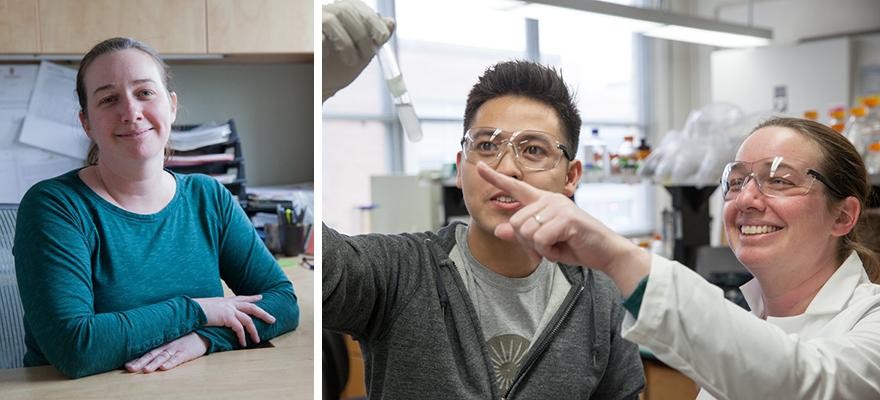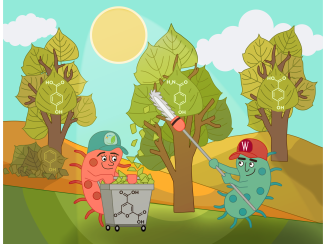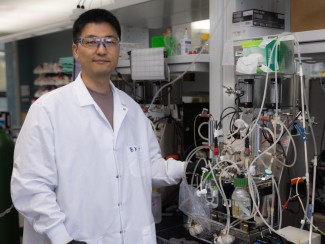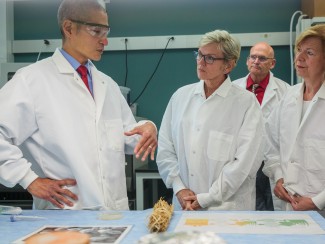
As a college sophomore at the University of California–San Diego, Jennifer Reed took a course on building boats and bridges. Though mechanical engineering had long been the “family business” – her father and both her grandfathers were engineers – Reed realized soon enough that hulls and trestles were not her true calling.
That keen family interest in engineering, however, had not skipped a generation.
“I was always interested in how things work,” says Reed, a 2014 recipient of the Presidential Early Career Award for Scientists and Engineers, an associate professor of chemical and biological engineering at the University of Wisconsin–Madison, and a scientist at the Great Lakes Bioenergy Research Center (GLBRC). “As a kid, I would look at the washing machine and wonder how it knew when the door was closed and it should start its cycle. But it wasn’t until college that I discovered it was much more interesting to apply engineering solutions to biological problems.”
After learning that the wide array of chemical reactions inside a living cell could be modeled with a computer, Reed became hooked on the field of metabolic engineering, the practice of optimizing cell processes to increase the production of desirable chemicals such as ethanol.
“I discovered that a cell’s metabolism is this incredibly complex system, but with all kinds of controls in place to make sure it doesn’t go awry,” Reed says. “It all seemed very logical. The cell is not some random thing that just happened to emerge. This engineer-minded description of biology really appealed to me.”
Before joining the UW–Madison faculty in 2007, Reed had spent her entire life in California. She grew up in the northern city of Redding, a place she describes as “very outdoorsy, full of beautiful mountains and lakes,” and the San Francisco Bay area. From there she moved 500 hundred miles south to attend the University of California–San Diego.
After completing her undergraduate degree in bioengineering, Reed decided to stay in San Diego for graduate school—in part for the pleasant climate and in part because of bioengineering professor Andrew McCulloch, one of three influential professors from her college years. He taught a class that “made a really good pitch for the importance of statistics,” but also encouraged her to apply for bioengineering Ph.D. programs. McCulloch’s gut feeling about Reed’s talent, of course, was right on the mark.
In her lab at UW–Madison, Reed now focuses on controlling thousands of reactions inside a cell by changing the genes that help produce a specific chemical. For example, in her GLBRC research she tweaks certain strains of yeast and bacteria so that they can better access and convert the sugar molecules contained in corn stover—the stalks, leaves, husks and cobs that remain in fields after the harvest—to ethanol and advanced biofuels.
And yet engineering challenges like these are not simple, nor are they limited to studying just one particular pathway within a cell. As Reed explains it, if you want a cell to produce a different kind of biofuel, such as isobutanol, you need to turn off the ethanol pathway and enhance flow into the pathway that makes isobutanol. Knowledge of the entire biological system is required to develop these kinds of strategies, which is why metabolism modelers like Reed are also called systems biologists.
Reed’s research approach is unique in that it combines computational modeling and lab work. Running experiments with living microbes allows her to compare their observed behavior to the computer’s predicted reactions and adjust the computer model accordingly. In the lab she studies the ubiquitous bacterium Escherichia coli (E. coli), found in the gut of humans and animals; cyanobacteria, a familiar sight as blue-green “algae” in freshwater lakes; and Zymomonas mobilis, a bacterium found in the sap of sugar-rich plants.
E. coli can be designed to produce hundreds of compounds that it doesn’t produce in nature. So you can make large amounts of biofuel with a small profit margin, and supplement that with smaller volumes of commodity chemicals that are much more profitable.
Jennifer Reed
Studying a variety of microbes could prove important to the biofuels industry, where specific microbes could be used to match the specific characteristics of different locales. Cyanobacteria, for example, which require only sunlight and carbon dioxide to produce biofuels, could be an ideal fit for sun-drenched states like Arizona.
But Reed’s computational design goes well beyond matching the industry’s geography with natural variation in a microbe’s preferred environment. Increasing the economic viability of the biofuel pipeline will require creating valuable co-products along the way. To that end Reed also works on converting cellulosic, or non-edible, plant material to the kinds of chemicals currently used to make plastic soda bottles, pesticides and pharmaceuticals, creating non-petroleum derived sources of a host of commercially valuable chemicals.
“E. coli can be designed to produce hundreds of compounds that it doesn’t produce in nature,” Reed says. “So you can make large amounts of biofuel with a small profit margin, and supplement that with smaller volumes of commodity chemicals that are much more profitable.”
Long-term, Reed’s goal is to be able to feed any arbitrary DNA sequence into a computer and predict not only the function of the genes contained in that sequence, but also the levels, inside a living cell, of the various products they control.
“I’m really interested in how DNA encodes the behavior of cells, whether we’ve engineered them or they occur naturally,” she says. “Right now, I have to do a lot of tinkering with various DNA elements to introduce a new pathway. But the more computational design that you can do, the less of that trial-and-error strategy is needed.”
The more computational design that someone like Reed is doing, the closer we all get to the much-needed transformation of the way we source energy. At the forefront of her field, Reed will add to her career honors early next month when she travels to Washington, D.C. to be inducted into the American Institute for Medical and Biological Engineering (AIMBE) College of Fellows, an honor bestowed upon only the top two percent of researchers working in that large and expanding field.
The GLBRC is one of three Department of Energy Bioenergy Research Centers created to make transformational breakthroughs and build the foundation of new cellulosic biofuels technology. For more information on the GLBRC, visit www.glbrc.org.





